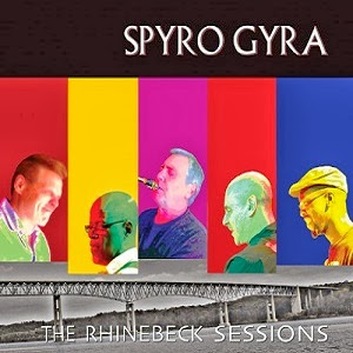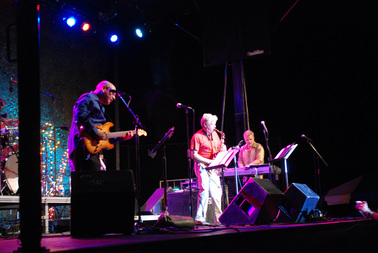
Spyro Gyra has gone through many personnel changes but Jay Beckenstein and Tom Schuman have been on every album and Julio Fernandez has been with them since 1984. Scott Ambush joined them in 1992 with Lee Pearson coming along in November of 2011. “The Rhinebeck Sessions” is the first album for the current line-up.
After repeatedly charting in Billboard’s Top Jazz Albums, their Grammy Awards (4) have been in the Best Pop Instrumental Album category. A bit perplexing since they have constantly employed the best Jazz musicians as session players: the Brecker Brothers, Steve Gadd, Tom Scott, Marcus Miller, Toots Thielmans and so many more.
It was the live band, however, that was the true core of Spyro Gyra. Staying with the core has been the band’s best strategy since 1999’s “Got the Magic” album. Aside from guest vocalists, it has been just the quintet who have done the studio work, as well. The once-divided aspect of Spyro Gyra has been replaced by a unified sound both live and in the studio.
Few sounds “just feel good” as does Jay Beckenstein’s sax alongside Tom Schuman’s keyboards. However, add Julio Fernandez’ guitar and Scott Ambush on bass with Lee Pearson on drums and the feeling can only be described as “Ah, Spyro Gyra!”

“Wishful Thinking” begins with that cool keyboard, bass and drum sound that is supported by Julio’s scratchy guitar. When Jay’s sax joins in, the swing is well-established and he stands right atop it. This is the “hold-your-baby-close” number on the album. The groove is light-hearted, even wistful. I deliberately avoid using the term “smooth” and you know why. Whatever term, it is sweet.
Perhaps it was the intimate setting of the studio in upstate New York or just the long association of brilliant musicians but there is an intimacy that emerges that is warm and welcoming. The album takes on an atmosphere of being entertained by close friends in a living room.
“Not Unlike That” is punchy with Scott Ambush’s slap-funk staccato. While some bassists may be accused of using that technique to masquerade a lack of talent, Scott uses it because it is appropriate to the percussive needs of the composition. Scott’s techniques and stylings have always been song-appropriate. The piece also has those signature sax-keyboards moments of being in lock-step between Jay and Tom wherein Lee again shows his unique contributions to a band accustomed to great drummers. Hidden beneath all of that, listen to Julio’s flawless timing of guitar support with a splendidly understated but oh-so-clean solo. Scott’s slap-funk solo brings the listener out of their seat and the unified march to the end is almost rapturous.
Julio introduces the next track with his own R&B guitar. As cool as the title suggests, “Sorbet” puts forth a syncopated backdrop from the rhythm section for Tom’s Fender Rhodes-sounding keyboards. Julio’s guitar lead follows after the keyboards and is in turn succeeded by Jay’s sax lead, all with Scott and Lee keeping the groove intact.
| | |
Lee opens “I Know What You Mingus” with chops to equal the great Dannie Richmond from the Mingus bands. Jay alone joins Lee for the first bars until the rest of the band hops on-board this lively piece, a piece that contains exciting piano leads, some of the jazziest percussion, a cool andante bass and that roaring sax.
It has been rightly said that it is impossible to explain Charles Mingus. One thing is assured, though, and that is that Spyro Gyra understands the feel of Mingus. This isn’t a tribute to Mingus or a cover of a Mingus piece. It is a celebration of the sound of Mingus as performed by seasoned Jazz musicians who have developed their own unique sound and who have employed that sound to praise another.
 The Clubhouse Studio in Rhinebeck, NY
The Clubhouse Studio in Rhinebeck, NY “Off the Cuff” is a showpiece for some of Jay’s hottest sax work. There is a hard drive to the introduction and that is relieved by the gentleness of Tom’s piano followed by the deliberate delicacy of Julio’s guitar. Jay’s sax slides back and forth between the glide and the grind. While Tom’s keys maintain the sweetness of the piece, Lee’s drumming creates its own melodic intent next to Scott’s argumentative bass. The debate between the musicians in “Off the Cuff” indeed carries extemporaneous moods and expressions--declamation to dialogue to diatribe to denouement.
Julio opens “Clubhouse Jam” with cool funk and the rest of the group falls in line. The “Clubhouse” is a reference to the Clubhouse Studio in Rhinesbeck, NY and thus the title of the album “The Rhinesbeck Sessions.” This is the track wherein Julio works the hardest. But there is an open-endedness in the approach from sax, keys and guitar and--like a good jam should--the trades are generous and energetic.
But that rhythm section! I should come clean that Scott Ambush is one of my favorite bassists. Now to hear him with Lee Pearson...well, as Lee would say, “To God be the Glory.” There is indeed a musical-spiritual harmony between these two that is so clear, so close that it is almost like telepathy. The steadily shifting times provide ample example of that single-mindedness between them.

This is almost the quintessential Spyro Gyra piece. Dynamism, lyricism, virtuosity and volatility, throw in a European police siren phrase and this song displays everything beloved of Spyro Gyra. This is beyond entertainment; it is enlightenment. The one with ears to hear cannot remain unchanged.
The album closes with “Who Knew!” It is a quirky tuned and timed piece which also exhibits masterful self-control in the understatement of each musician. The song has instances of surging like it is about to take off but is then reined in again while, in the background, someone is laughing like a teaser. The discipline is required of the player and the hearer as the jester/composer mocks everyone. Very intriguing.
With “The Rhinebeck Sessions,” Spyro Gyra have reached another mile-marker. They have never disappointed. They have often surprised. They have always delighted.
It began with “Shaker Song” from the 1977 LP and seeing a fresh, energetic group in August of 1978 at the Renaissance Plaza Hotel in Detroit. Move forward 18 years to “Westwood Moon” from “Heart of the Night” and hearing a much more experienced band at Chastain Park in Atlanta in 1996. Then another 14 years before “What It Is” from “Down to the Wire” and seeing a greyer, older but incredibly more intuitive and interactive band at Esther Short Park in Vancouver, Washington in 2010.
I confess. I have admired Spyro Gyra since that very first song on the very first album through every single one of the albums since. I own them all. They have brought joy where there was none. They have grown, they have changed and they have changed me.
"The Rhinebeck Sessions" by Spyro Gyra can be purchased here.
 RSS Feed
RSS Feed
